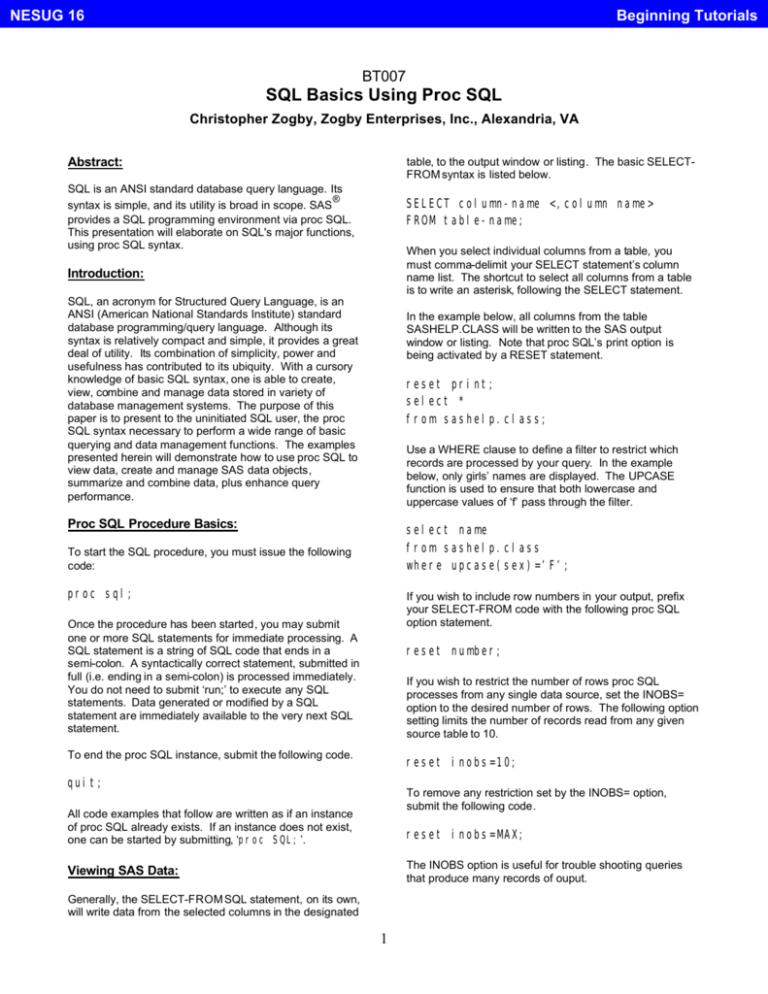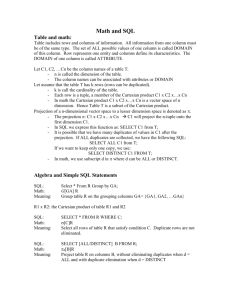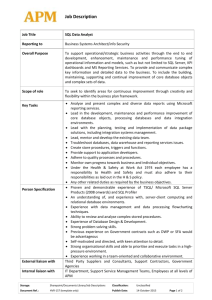
NESUG 16
Beginning Tutorials
BT007
SQL Basics Using Proc SQL
Christopher Zogby, Zogby Enterprises, Inc., Alexandria, VA
Abstract:
table, to the output window or listing. The basic SELECTFROM syntax is listed below.
SQL is an ANSI standard database query language. Its
®
syntax is simple, and its utility is broad in scope. SAS
provides a SQL programming environment via proc SQL.
This presentation will elaborate on SQL's major functions,
using proc SQL syntax.
SELECT column-name <,column name>
FROM table-name;
When you select individual columns from a table, you
must comma-delimit your SELECT statement’s column
name list. The shortcut to select all columns from a table
is to write an asterisk, following the SELECT statement.
Introduction:
SQL, an acronym for Structured Query Language, is an
ANSI (American National Standards Institute) standard
database programming/query language. Although its
syntax is relatively compact and simple, it provides a great
deal of utility. Its combination of simplicity, power and
usefulness has contributed to its ubiquity. With a cursory
knowledge of basic SQL syntax, one is able to create,
view, combine and manage data stored in variety of
database management systems. The purpose of this
paper is to present to the uninitiated SQL user, the proc
SQL syntax necessary to perform a wide range of basic
querying and data management functions. The examples
presented herein will demonstrate how to use proc SQL to
view data, create and manage SAS data objects,
summarize and combine data, plus enhance query
performance.
In the example below, all columns from the table
SASHELP.CLASS will be written to the SAS output
window or listing. Note that proc SQL’s print option is
being activated by a RESET statement.
reset print;
select *
from sashelp.class;
Use a WHERE clause to define a filter to restrict which
records are processed by your query. In the example
below, only girls’ names are displayed. The UPCASE
function is used to ensure that both lowercase and
uppercase values of ‘f’ pass through the filter.
Proc SQL Procedure Basics:
select name
from sashelp.class
where upcase(sex)=’F’;
To start the SQL procedure, you must issue the following
code:
proc sql;
If you wish to include row numbers in your output, prefix
your SELECT-FROM code with the following proc SQL
option statement.
Once the procedure has been started, you may submit
one or more SQL statements for immediate processing. A
SQL statement is a string of SQL code that ends in a
semi-colon. A syntactically correct statement, submitted in
full (i.e. ending in a semi-colon) is processed immediately.
You do not need to submit ‘run;’ to execute any SQL
statements. Data generated or modified by a SQL
statement are immediately available to the very next SQL
statement.
reset number;
If you wish to restrict the number of rows proc SQL
processes from any single data source, set the INOBS=
option to the desired number of rows. The following option
setting limits the number of records read from any given
source table to 10.
To end the proc SQL instance, submit the following code.
reset inobs=10;
quit;
To remove any restriction set by the INOBS= option,
submit the following code.
All code examples that follow are written as if an instance
of proc SQL already exists. If an instance does not exist,
one can be started by submitting, ‘proc SQL;’.
reset inobs=MAX;
The INOBS option is useful for trouble shooting queries
that produce many records of ouput.
Viewing SAS Data:
Generally, the SELECT-FROM SQL statement, on its own,
will write data from the selected columns in the designated
1
NESUG 16
Beginning Tutorials
Describing a SAS Table or View:
methods for defining an integrity constraint, written in
italicized text, have been used. Because of these integrity
constraints, no row of data can be inserted if the NAME
field is null, or the SEX field contains any value other than
‘M’ or ‘F’. Other integrity constraints have been available
since the release of SAS V8, and it’s recommended that
you explore further this relatively new (to SAS), but highly
useful feature.
Proc SQL’s DESCRIBE TABLE statement writes, to the
SAS log, structural information on the requested table.
The statement’s syntax is listed below.
DESCRIBE TABLE table-name;
Note that the DESCRIBE TABLE statement’s output is
written as a valid SQL CREATE TABLE statement. This
feature’s output can be used to recreate the described
table in SAS or another relational database system. A
word of warning: the recreated table would have 0
observations.
You can create a blank clone of another table by using the
CREATE TABLE statement with the LIKE clause.
A SQL view is a stored query whose instructions are
processed when the view is executed. A view contains no
actual data, however its execution may lead to the
creation of data. Proc SQL’s DESCRIBE VIEW statement
writes to the SAS log the SQL view’s definition in the form
of a valid SELECT-FROM statement. This feature allows
the user to see how the described view was defined. The
statement’s syntax is listed below.
Finally, you can create a table via a query expression.
DESCRIBE VIEW view-name;
The result of your query expression is written to a SAS
table, specified in table-name. In the following example, a
table WORK.MALES is created by selecting all columns
from SASHELP.CLASS, and only those records where the
column, SEX, has the value ‘M’. The resulting table is
sorted in descending order by weight. In the ORDER BY
statement, the keyword DESC, causes the sort to be in
descending order for the column(s) after which it
immediately follows. By default the ORDER BY statement
sorts data in ascending order.
CREATE TABLE table-name LIKE
table-name;
CREATE TABLE table-name AS
query-expression
<ORDER BY order-by-item <,order-byitem>...>;
Creating a SAS Table or View:
There are three ways in which you can create a table
using proc SQL, all of which use the CREATE TABLE
statement. The first method creates a blank table with
columns and their assigned data types as they are
explicitly defined. This method’s syntax, shown below, is
the same returned by DESCRIBE TABLE.
create table males as
select *
from sashelp.class
where sex=’M’
order by weight desc;
CREATE TABLE table-name (columnspecification <, column-specification>
...<, constraint-specification> ...);
The code below creates a blank table in the WORK library
called CLASS.
SAS SQL views can only be created via a query
expression.
CREATE WORK.TABLE CLASS
(
name char(8) not null,
sex char(1),
age num,
height num,
weight num,
constraint sex_MF
check(sex in('M','F'))
);
CREATE VIEW view-name AS
query-expression
<ORDER BY order-by-item <,order-byitem>...>;
Based on the following example, the view,
TALLEST_FEM, when executed, will produce a single row
containing the greatest value of HEIGHT for those records
whose column SEX = ‘F’. Note that we are using the
MAX() function to determine what value of HEIGHT is the
greatest from among all the rows that have the column
SEX = ‘F’. Also note that we are storing the result of our
summary function into a new column called
MAX_F_HEIGHT.
The newly created table, WORK.CLASS, has 5 columns.
The columns NAME and SEX are character type and have
lengths of 8 and 1 byte, respectively. The remaining three
columns, AGE, HEIGHT and WEIGHT are numeric type
and by default store 8 bytes each. Integrity constraints
have been defined for the columns NAME and SEX. Both
2
NESUG 16
Beginning Tutorials
create view tallest_fem as
select max(height) as max_f_height
from sashelp.class
where sex=’F’;
restricting which rows are processed, it restricts which
post-summarized data are returned. In the example
below, the SASHELP.CLASS table is summarized by SEX
and AGE, producing a single record for each age within
each sex type that has an average height greater than 60.
The resulting records will be written to the table
WORK.HEIGHT_SUM. Note that the HAVING clause
evaluates a summarized value, avg(height), against a
constant, 60. The summary function, which returns an
average value for height, does so for each combination of
values listed in the GROUP BY statement (i.e. SEX and
AGE). If, for instance, the average height for girls who are
13 years old is greater than 60, then that record’s
summarized height values as listed in the SELECT
statement are written to WORK.HEIGHT_SUM.
Dropping SAS Tables and Views:
You can use proc SQL to delete or drop tables and views.
The syntax for dropping tables and views is listed below.
DROP TABLE table-name <,table-name>
...;
DROP VIEW
viewname <,viewname> ...;
create table height_sum as
select sex,
age,
count(*) as count,
avg(height) as
avg_height,
min(height) as min_height,
max(height) as max_height,
std(height) as std_height
from sashelp.class
group by sex,
age
having avg(height) > 60;
The following proc SQL statement deletes the tables
TEMP1 and TEMP2 from the WORK library:
drop table temp1, temp2;
Summarizing Data:
Stratification for data summarization is defined in SQL’s
GROUP BY statement. Proc SQL can produce a table or
listing that contains summary level information for each
unique value within a column or combination of values
across columns listed in its GROUP BY statement. For
instance, the following query lists, as SAS output, totals for
the number of boys and girls in the table
SASHELP.CLASS:
Combining Data:
select sex,
count(*) as count
from sashelp.class
group by sex
order by count desc;
There are many ways to combine data from two or more
data sources. This paper will demonstrate how to control
how data sources are combined using various SQL joins.
There are two principle types of joins: inner and outer (full,
right and left). An inner join produces a result set that
contain records from all source tables that share common
key column(s) values. The syntax to perform an inner join
is listed below.
Because SEX appears in the GROUP BY statement, the
summary function, COUNT(*), produces a total count for
each unique value of SEX (in our example, assume the
column SEX contains only two possible values: ‘M’ and
‘F’). This query will yield two columns, with two records:
one record containing the total number of boys and
another with the total number of girls. The most common
sex will be listed first, because the ORDER BY statement
sorts our results in descending order by the calculated
field, COUNT.
select a.index,
a.field1,
b.field2
from one a
inner join
two b
on a.index=b.index;
Generally, only those fields listed in the GROUP BY
statement, plus any summarized fields are listed in the
SELECT statement. For some SQL (DB2 & Oracle) this is
a rule, however SAS’s proc SQL does not impose the said
restriction. It’s recommended that you follow this rule, until
you become more familiar with how SQL summarizes
data.
Notice that between the source table names ONE and
TWO, the join type, INNER JOIN, is listed. The join
criterion, which defines which key columns proc SQL will
compare, is listed in the ON statement. Also note that the
letters ‘a’ and ‘b’, that immediately follow the table names
in the FROM statement, are used as shorthand table
references to distinguish between commonly named fields
that exist on more than one table.
SQL allows you to filter your summarized results via the
HAVING clause. The HAVING clause works in the same
fashion as a SQL WHERE clause except that, instead of
3
NESUG 16
Beginning Tutorials
The results set will contain all records from WORK.ONE
and WORK.TWO that have matching key column values
stored in the fields INDEX. When proc SQL finds a match
between INDEX from WORK.ONE and INDEX from
WORK.TWO, FIELD1 from WORK.ONE is combined on
the same result set record with FIELD2 from WORK.TWO.
The optional UNIQUE keyword applies a constraint on the
table, preventing any indexed columns from having
duplicate values. You can not create a unique index on a
column or columns that contain duplicate values.
The code below creates a simple index on the column
SEX, and a unique composite index SEX_NAME on the
columns SEX and NAME on the table SASHELP.CLASS.
An outer join writes as output, in addition to those records
that match on key columns, records that do not have key
column(s) matches. A full outer join returns all matching
records, plus all records from all source tables that do not
have key column(s) matches. A left outer join, will return
all records from the table on the left hand side of the join
type definition, and only those matching records from the
table immediately to the right of the join type definition. A
right outer join returns matching records from the table on
the left hand side of the join type definition, and all records
from the table immediately to the right of the join type
definition.
create index sex
on sashelp.class;
create unique index sex_name
on sashelp.class(sex, name);
To drop an index, use the following SQL syntax.
DROP INDEX indexname
FROM table-name;
In the sample SQL code below, we perform a left join
between WORK.MASTER_LIST and WORK.DEATH_LIST
on common values of social security number (SSN). SSN,
LAST_PAY and LAST_PAY_DT for all rows of
WORK.MASTER_LIST and DEATH_DT from any
matching records on WORK.DEATH_LIST are returned.
<,indexname> ...
The code below drops the composite index SEX_NAME
from SASHELP.CLASS.
drop index sex_name
from sashelp.class;
select a.ssn,
a.last_pay,
a.last_pay_dt,
b.death_dt
from master_list a
left join
death_list b
on a.ssn = b.ssn;
Conclusions:
Proc SQL provides a SQL gateway to the SAS system. A
general knowledge of proc SQL syntax allows the SAS
programmer to exploit the variety of programming,
querying and data management capabilities afforded by
SQL. Also, this general knowledge can be used to reduce
the learning curve for programming tasks in other nonSAS, SQL-based databases such as Oracle and DB2.
Creating/Dropping Indexes:
Contact Information:
An index is an object associated with a specific table that
stores information on where in the said table the values of
the indexed column or columns are stored. An index acts
as a virtual sort, without affecting the physical order of
data within its associated table. An index can greatly
improve query performance, however its efficacy can vary
due to a number of factors. Improving query performance
is a complex subject matter, and is beyond the scope of
this paper. I encourage the user to explore further how to
improve query performance using indexes.
Please feel free to send comments or questions to:
Christopher Zogby
Zogby Enterprises, Inc.
3901 Terrett Court
Alexandria, VA 22311
Phone:
Fax:
Email:
Web:
You can create multiple simple (single column) and
composite indexes (two or more columns) for a given
table. The syntax to create an index is listed below.
®
(703) 671.6330
(703) 671.6360
info@zogbyenterprises.com
www.zogbyenterprises.com
SAS and all other SAS Institute Inc. product or service
names are registered trademarks or trademarks of SAS
®
Institute Inc. in the USA and other countries. indicates
USA registration. Other brand and product names are
registered trademarks or trademarks of their respective
companies.
CREATE <UNIQUE> INDEX indexname ON
table-name (column <,column> ...);
4










